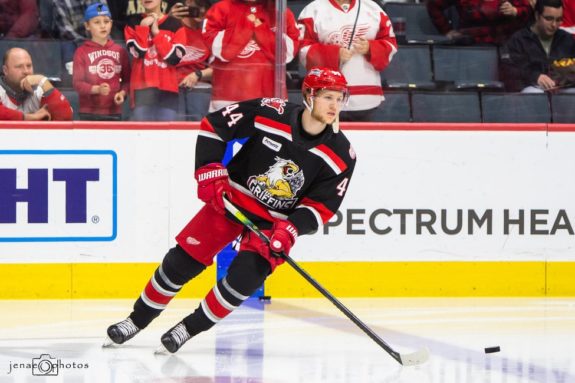When all is said and done and the dust settles, we may look back on the Detroit Red Wings’ 2017 draft class and be amazed at how things worked out. After selecting forward Michael Rasmussen with the ninth overall pick, the Red Wings followed it up by going a bit off the board with their second round pick – like way off the board.
Ranked as the 25th-best European skater by Central Scouting, defenseman Gustav Lindstrom was completely absent from TSN’s Craig Button’s top 105 rankings heading into the 2017 draft. And yet there he was, hearing his name called out by the Red Wings at pick 38. For some, the instant reaction to the pick was probably “does Detroit realize his name is Lindstrom and not Lidstrom?”

Now in his first full season in the NHL, Lindstrom has started to really make a name for himself in Detroit. While the 23-year-old’s ceiling is nowhere near the player who has a strikingly similar name to his, that hasn’t stopped him from developing into a steady presence on the Red Wings’ blue line. In fact, he’s become so steady that you’d be forgiven if you rarely notice him on a night-to-night basis.
Lindstrom is a Classic Stay At Home Defender
There’s that old saying about defensemen where if you never hear their name or notice them, then that means they’re doing their job. In 2022, however, we live in an era where “modern day defensemen” act as fourth forwards on the ice, with players like Adam Fox and Cale Makar regularly leading the Norris Trophy debate due in part to how effective they are at leading the attack for their respective teams. Even Red Wings defenseman Moritz Seider is praised league-wide for making the types of plays that television broadcasts love to highlight.
Amongst all this talk about what it takes to be an effective and elite defenseman in the NHL, Lindstrom is a player that is the embodiment of that old saying. With just nine points through 38 games this season, nobody’s going to call him an offensive defenseman. In fact, since he was drafted, the most points he’s put up in a single season was during the 2017-18 season, where he put up 14 points in 39 games while playing in the HockeyAllsvenskan – essentially the Swedish equivalent of the American Hockey League (AHL). He doesn’t make his living by leading the attack, he makes his living by defending against it.
Consider that, as a whole, the Red Wings have a minus-29 goal-differential this season, but Lindstrom leads all Detroit defensemen with a plus-2 rating. While he only averages 16:11 in ice-time this season, he’s done well to make sure that he isn’t hurting his team when he is out on the ice.
Lindstrom has an even-strength goals-for percentage of 51.2, per Natural Stat Trick. He starts just under half of his shifts in the offensive zone, meaning that head coach Jeff Blashill isn’t over-sheltering him despite his youth and lack of experience at the NHL level. At worst, he’s giving the Red Wings break-even defense. At best, he might be the Red Wings’ second-best guy on the blue line.
Lindstrom Proves Red Wings’ Expansion Strategy was Correct
Heading into the Seattle Expansion Draft this past offseason, a lot of debate was had over who would be the third defenseman protected by the Red Wings. Filip Hronek and newly-acquired Nick Leddy were virtual locks to be protected, but three other defensemen were ripe for the picking, and Detroit could only protect one: Lindstrom, Dennis Cholowski and Troy Stecher. The Red Wings eventually opted to protect Lindstrom, the youngest of the three. As you probably know by now, the Seattle Kraken chose Cholowski as their pick from Detroit.
Since then, Lindstrom has only missed games this season if he was sick or injured. He cracked the opening night roster, beating out Stecher and his over 300 games of NHL experience, and hasn’t let go of his roster spot since. Cholowski, on the other hand, has played in just seven games this season, all with the Washington Capitals after they plucked him off of the waivers from the Kraken. The Kraken reclaimed him on waivers just a few days ago on Feb. 9.

It may have seemed like a puzzling move, at the time, to protect Lindstrom over the other two defenders. Stecher was generally viewed as a positive addition to the team last season after forming a relatively effective second defensive pairing with Marc Staal. Cholowski was the Red Wings’ first pick, 20th overall, in the 2016 draft, and many people in and outside of the organization still held the belief in his potential as an offensive defenseman.
In a small sample size, Lindstrom had showed well, but his potential has never been as high as Cholowski’s, and he wasn’t (and still isn’t) a proven product at the NHL level. As solid as Lindstrom has been this season, it would have been valid to worry that he would fizzle out this season; to some, it may have seemed like the Red Wings opted to protect the least-impactful player out of those three defensemen.
As it stands right now, however, it appears that the Red Wings made the right choice.
Lindstrom A Building Block for the Future?
The Red Wings’ biggest strength in terms of their prospect pool is on the blue line. Realistically, they have more promising defensive prospects than the team will have roster spots for – and that’s without factoring in Lindstrom, Hronek and Seider, all of which are already on the Red Wings’ roster and are under the age of 25. Tough choices are coming up for the Red Wings, but they’re the kind of tough decisions that teams only have if they’ve been drafting well.
Related: Red Wings Top 25 Prospects: 2021-22 Midseason Update
Lindstrom’s play this season has cemented the Red Wings’ strength on the right side of the blue line. He’s been able to contribute on the penalty kill, and he’s not hurting his team at even-strength. It wasn’t that long ago that the only Detroit defenseman making a positive impact was Hronek; Lindstrom making a positive impact on the Red Wings’ bottom pairing has given Detroit defensive depth they haven’t had since Niklas Kronwall’s heyday, and it’s a big reason why the Red Wings are playing .500 hockey this season.

Does that mean that Lindstrom is now entrenched as a member of the Red Wings’ core going forward? Probably not, at least not yet. Third-pairing defensemen are rarely talked about, but having a quality third pairing can be what separates one team from another in the playoffs. While the Red Wings aren’t a playoff contender quite yet, they’ll want to have quality players in those types of roles when they do reach that level. If he can maintain and even build on the successes of this season, he could play his way into a long-term role with the Red Wings. Heck, his defensive style could even be the perfect compliment to the Red Wings’ top prospect, Simon Edvinsson, next season (assuming Edvinsson makes the team).
Lindstrom isn’t going to wow you with lightning speed or elite offensive plays. If you do notice him, it will likely be because he blocks a shot, disrupts a play, or because he makes a simple, clean pass to get the puck moving in the right direction. Those types of players don’t win Norris Trophies, but they are a key part of the best teams in the league.
If the Red Wings are going to become one of those teams, they’ll need players like Lindstrom to own their role and continue to get better at it. That’s the next challenge for the 23-year-old, and if his play through 67 NHL games is any indication, it looks like that’s a challenge he’s ready to take on.
